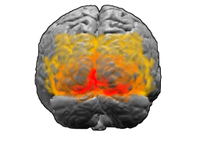
Photo from wikipedia
Proper location of the mitotic spindle is critical for chromosome segregation and the selection of the cell division plane. However, how mitotic spindles sense cell size and shape to regulate… Click to show full abstract
Proper location of the mitotic spindle is critical for chromosome segregation and the selection of the cell division plane. However, how mitotic spindles sense cell size and shape to regulate their own position and orientation is still largely unclear. To investigate this question systematically, we used a general model by considering chromosomes, microtubule dynamics, and forces of various molecular motors. Our results show that in cells of various sizes and shapes, spindles can always be centered and oriented along the long axis robustly in the absence of other specified mechanisms. We found that the characteristic time of positioning and orientation processes increases with cell size. Spindles sense the cell size mainly by the cortical force in small cells and by the cytoplasmic force in large cells. In addition to the cell size, the cell shape mainly influences the orientation process. We found that more slender cells have a faster orientation process, and the final orientation is not necessarily along the longest axis but is determined by the radial profile and the symmetry of the cell shape. Finally, our model also reproduces the separation and repositioning of the spindle poles during the anaphase. Therefore, our work provides a general tool for studying the mitotic spindle across the whole mitotic phase.
Journal Title: Physical Review E
Year Published: 2018
Link to full text (if available)
Share on Social Media: Sign Up to like & get
recommendations!